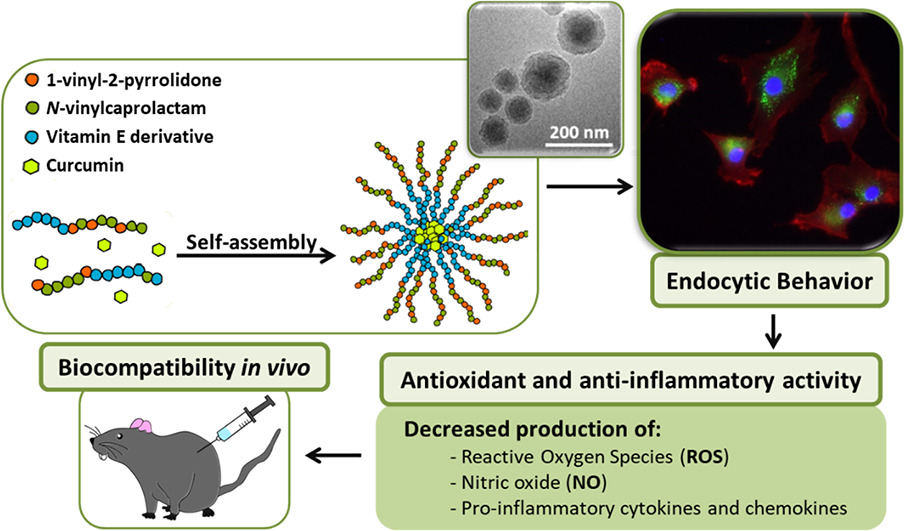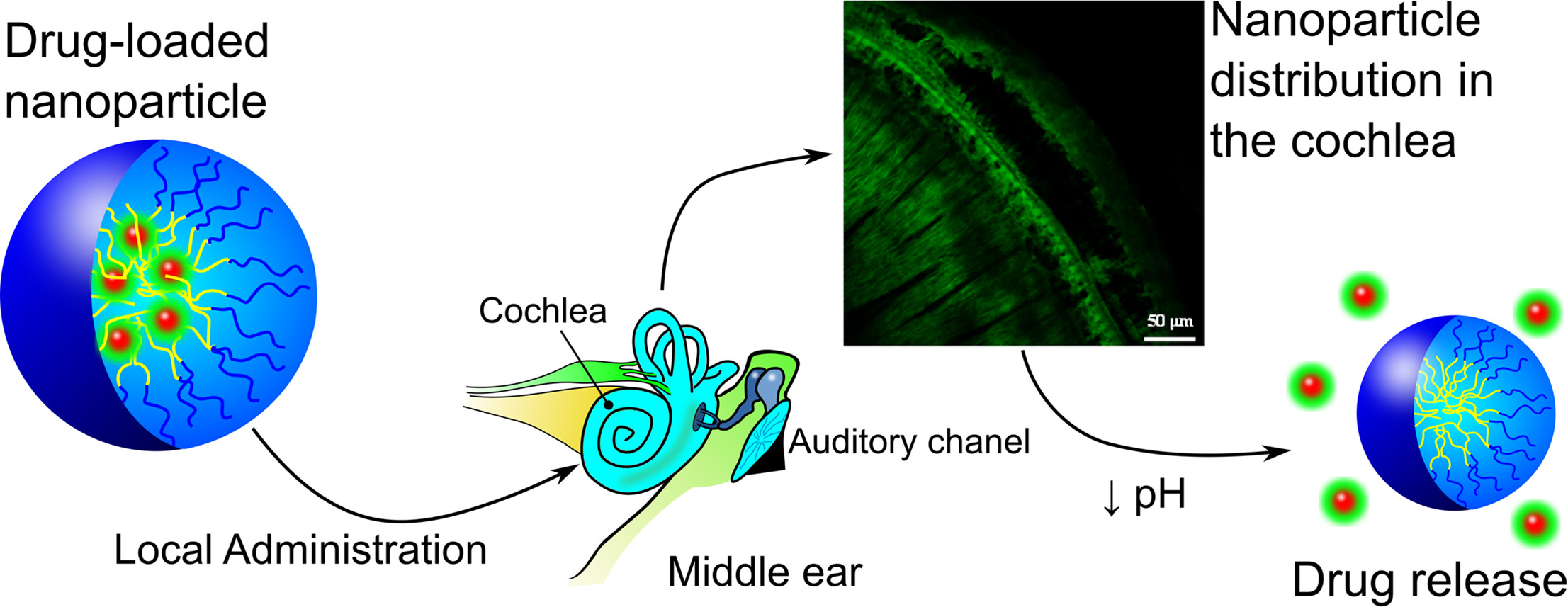Oxidative stress and inflammation are two related processes common to many diseases. Curcumin is a natural compound with both antioxidant and anti-inflammatory properties, among others, that is recently being used as a natural occurring product alternative to traditional drugs. However, it has a hydrophobic nature that compromises its solubility in physiological fluids and its circulation time and also presents cytotoxicity problems in its free form, limiting the range of concentrations to be used. In order to overcome these drawbacks and taking advantage of the benefits of nanotechnology, the aim of this work is the development of curcumin loaded polymeric nanoparticles that can provide a controlled release of the drug and enlarge their application in the treatment of inflammatory and oxidative stress related diseases. Specifically, the vehicle is a bioactive terpolymer based on a α-tocopheryl methacrylate, 1-vinyl-2-pyrrolidone and N-vinylcaprolactam. Nanoparticles were obtained by nanoprecipitation and characterized in terms of size, morphology, stability, encapsulation efficiency and drug release. In vitro cellular assays were performed in human articular chondrocyte and RAW 264.7 cultures to assess cytotoxicity, cellular uptake, antioxidant and anti-inflammatory properties. The radical scavenging activity of the systems was confirmed by the DPPH test and the quantification of cellular reactive oxygen species. The anti-inflammatory potential of these systems was demonstrated by the reduction of different pro-inflammatory factors such as IL-8, MCP and MIP in chondrocytes; and nitric oxide, IL-6, TNF-α and MCP-1, among others, in RAW 264.7. Finally, the in vivo biocompatibility was confirmed in a rat model by subcutaneously injecting the nanoparticle dispersions. The reduction of curcumin toxicity and the antioxidant, anti-inflammatory and biocompatibility properties open the door to deeper in vitro and in vivo research on these curcumin loaded polymeric nanoparticles to treat inflammation and oxidative stress based diseases.
3729048
{3729048:NSAC8C5G}
nature
50
1
1
title
819
http://www.biomateriales.ictp.csic.es/wp-content/plugins/zotpress/
%7B%22status%22%3A%22success%22%2C%22updateneeded%22%3Afalse%2C%22instance%22%3A%22zotpress-831cac642894b92f4dd2646dd0888f07%22%2C%22meta%22%3A%7B%22request_last%22%3A0%2C%22request_next%22%3A0%2C%22used_cache%22%3Atrue%7D%2C%22data%22%3A%5B%7B%22key%22%3A%22NSAC8C5G%22%2C%22library%22%3A%7B%22id%22%3A3729048%7D%2C%22meta%22%3A%7B%22creatorSummary%22%3A%22Pontes-Quero%20et%20al.%22%2C%22parsedDate%22%3A%222021-02-01%22%2C%22numChildren%22%3A1%7D%2C%22bib%22%3A%22%3Cdiv%20class%3D%5C%22csl-bib-body%5C%22%20style%3D%5C%22line-height%3A%202%3B%20%5C%22%3E%5Cn%20%3Cdiv%20class%3D%5C%22csl-entry%5C%22%20style%3D%5C%22clear%3A%20left%3B%20%5C%22%3E%5Cn%20%3Cdiv%20class%3D%5C%22csl-left-margin%5C%22%20style%3D%5C%22float%3A%20left%3B%20padding-right%3A%200.5em%3B%20text-align%3A%20right%3B%20width%3A%201em%3B%5C%22%3E1.%3C%5C%2Fdiv%3E%3Cdiv%20class%3D%5C%22csl-right-inline%5C%22%20style%3D%5C%22margin%3A%200%20.4em%200%201.5em%3B%5C%22%3EPontes-Quero%2C%20G.%20M.%2C%20Benito-Garz%5Cu00f3n%2C%20L.%2C%20P%5Cu00e9rez%20Cano%2C%20J.%2C%20Aguilar%2C%20M.%20R.%20%26%20V%5Cu00e1zquez-Lasa%2C%20B.%20%3Ca%20target%3D%27_blank%27%20href%3D%27http%3A%5C%2F%5C%2Fwww.sciencedirect.com%5C%2Fscience%5C%2Farticle%5C%2Fpii%5C%2FS0928493120337127%27%3EAmphiphilic%20polymeric%20nanoparticles%20encapsulating%20curcumin%3A%20Antioxidant%2C%20anti-inflammatory%20and%20biocompatibility%20studies%3C%5C%2Fa%3E.%20%3Ci%3EMaterials%20Science%20and%20Engineering%3A%20C%3C%5C%2Fi%3E%20%3Cb%3E121%3C%5C%2Fb%3E%2C%20111793%20%282021%29.%20%3Ca%20title%3D%27Cite%20in%20RIS%20Format%27%20class%3D%27zp-CiteRIS%27%20href%3D%27http%3A%5C%2F%5C%2Fwww.biomateriales.ictp.csic.es%5C%2Fwp-content%5C%2Fplugins%5C%2Fzotpress%5C%2Flib%5C%2Frequest%5C%2Frequest.cite.php%3Fapi_user_id%3D3729048%26amp%3Bitem_key%3DNSAC8C5G%27%3ECite%3C%5C%2Fa%3E%20%3C%5C%2Fdiv%3E%5Cn%20%3C%5C%2Fdiv%3E%5Cn%3C%5C%2Fdiv%3E%22%2C%22data%22%3A%7B%22itemType%22%3A%22journalArticle%22%2C%22title%22%3A%22Amphiphilic%20polymeric%20nanoparticles%20encapsulating%20curcumin%3A%20Antioxidant%2C%20anti-inflammatory%20and%20biocompatibility%20studies%22%2C%22creators%22%3A%5B%7B%22creatorType%22%3A%22author%22%2C%22firstName%22%3A%22Gloria%20Mar%5Cu00eda%22%2C%22lastName%22%3A%22Pontes-Quero%22%7D%2C%7B%22creatorType%22%3A%22author%22%2C%22firstName%22%3A%22Lorena%22%2C%22lastName%22%3A%22Benito-Garz%5Cu00f3n%22%7D%2C%7B%22creatorType%22%3A%22author%22%2C%22firstName%22%3A%22Juan%22%2C%22lastName%22%3A%22P%5Cu00e9rez%20Cano%22%7D%2C%7B%22creatorType%22%3A%22author%22%2C%22firstName%22%3A%22Mar%5Cu00eda%20Rosa%22%2C%22lastName%22%3A%22Aguilar%22%7D%2C%7B%22creatorType%22%3A%22author%22%2C%22firstName%22%3A%22Blanca%22%2C%22lastName%22%3A%22V%5Cu00e1zquez-Lasa%22%7D%5D%2C%22abstractNote%22%3A%22Oxidative%20stress%20and%20inflammation%20are%20two%20related%20processes%20common%20to%20many%20diseases.%20Curcumin%20is%20a%20natural%20compound%20with%20both%20antioxidant%20and%20anti-inflammatory%20properties%2C%20among%20others%2C%20that%20is%20recently%20being%20used%20as%20a%20natural%20occurring%20product%20alternative%20to%20traditional%20drugs.%20However%2C%20it%20has%20a%20hydrophobic%20nature%20that%20compromises%20its%20solubility%20in%20physiological%20fluids%20and%20its%20circulation%20time%20and%20also%20presents%20cytotoxicity%20problems%20in%20its%20free%20form%2C%20limiting%20the%20range%20of%20concentrations%20to%20be%20used.%20In%20order%20to%20overcome%20these%20drawbacks%20and%20taking%20advantage%20of%20the%20benefits%20of%20nanotechnology%2C%20the%20aim%20of%20this%20work%20is%20the%20development%20of%20curcumin%20loaded%20polymeric%20nanoparticles%20that%20can%20provide%20a%20controlled%20release%20of%20the%20drug%20and%20enlarge%20their%20application%20in%20the%20treatment%20of%20inflammatory%20and%20oxidative%20stress%20related%20diseases.%20Specifically%2C%20the%20vehicle%20is%20a%20bioactive%20terpolymer%20based%20on%20a%20%5Cu03b1-tocopheryl%20methacrylate%2C%201-vinyl-2-pyrrolidone%20and%20N-vinylcaprolactam.%20Nanoparticles%20were%20obtained%20by%20nanoprecipitation%20and%20characterized%20in%20terms%20of%20size%2C%20morphology%2C%20stability%2C%20encapsulation%20efficiency%20and%20drug%20release.%20In%20vitro%20cellular%20assays%20were%20performed%20in%20human%20articular%20chondrocyte%20and%20RAW%20264.7%20cultures%20to%20assess%20cytotoxicity%2C%20cellular%20uptake%2C%20antioxidant%20and%20anti-inflammatory%20properties.%20The%20radical%20scavenging%20activity%20of%20the%20systems%20was%20confirmed%20by%20the%20DPPH%20test%20and%20the%20quantification%20of%20cellular%20reactive%20oxygen%20species.%20The%20anti-inflammatory%20potential%20of%20these%20systems%20was%20demonstrated%20by%20the%20reduction%20of%20different%20pro-inflammatory%20factors%20such%20as%20IL-8%2C%20MCP%20and%20MIP%20in%20chondrocytes%3B%20and%20nitric%20oxide%2C%20IL-6%2C%20TNF-%5Cu03b1%20and%20MCP-1%2C%20among%20others%2C%20in%20RAW%20264.7.%20Finally%2C%20the%20in%20vivo%20biocompatibility%20was%20confirmed%20in%20a%20rat%20model%20by%20subcutaneously%20injecting%20the%20nanoparticle%20dispersions.%20The%20reduction%20of%20curcumin%20toxicity%20and%20the%20antioxidant%2C%20anti-inflammatory%20and%20biocompatibility%20properties%20open%20the%20door%20to%20deeper%20in%20vitro%20and%20in%20vivo%20research%20on%20these%20curcumin%20loaded%20polymeric%20nanoparticles%20to%20treat%20inflammation%20and%20oxidative%20stress%20based%20diseases.%22%2C%22date%22%3A%22February%201%2C%202021%22%2C%22language%22%3A%22en%22%2C%22DOI%22%3A%2210.1016%5C%2Fj.msec.2020.111793%22%2C%22ISSN%22%3A%220928-4931%22%2C%22url%22%3A%22http%3A%5C%2F%5C%2Fwww.sciencedirect.com%5C%2Fscience%5C%2Farticle%5C%2Fpii%5C%2FS0928493120337127%22%2C%22collections%22%3A%5B%5D%2C%22dateModified%22%3A%222021-01-14T08%3A39%3A09Z%22%7D%7D%5D%7D
1.
Pontes-Quero, G. M., Benito-Garzón, L., Pérez Cano, J., Aguilar, M. R. & Vázquez-Lasa, B.
Amphiphilic polymeric nanoparticles encapsulating curcumin: Antioxidant, anti-inflammatory and biocompatibility studies.
Materials Science and Engineering: C 121, 111793 (2021).
Cite


